DollarSprout Side Hustle Report 2024: Side Hustle Statistics and Industry Overview
Our readers always come first
The content on DollarSprout includes links to our advertising partners. When you read our content and click on one of our partners’ links, and then decide to complete an offer — whether it’s downloading an app, opening an account, or some other action — we may earn a commission from that advertiser, at no extra cost to you.
Our ultimate goal is to educate and inform, not lure you into signing up for certain offers. Compensation from our partners may impact what products we cover and where they appear on the site, but does not have any impact on the objectivity of our reviews or advice.
More people are side hustling than ever before. Explore the evolving landscape of gig work and its relationship with the traditional job market.
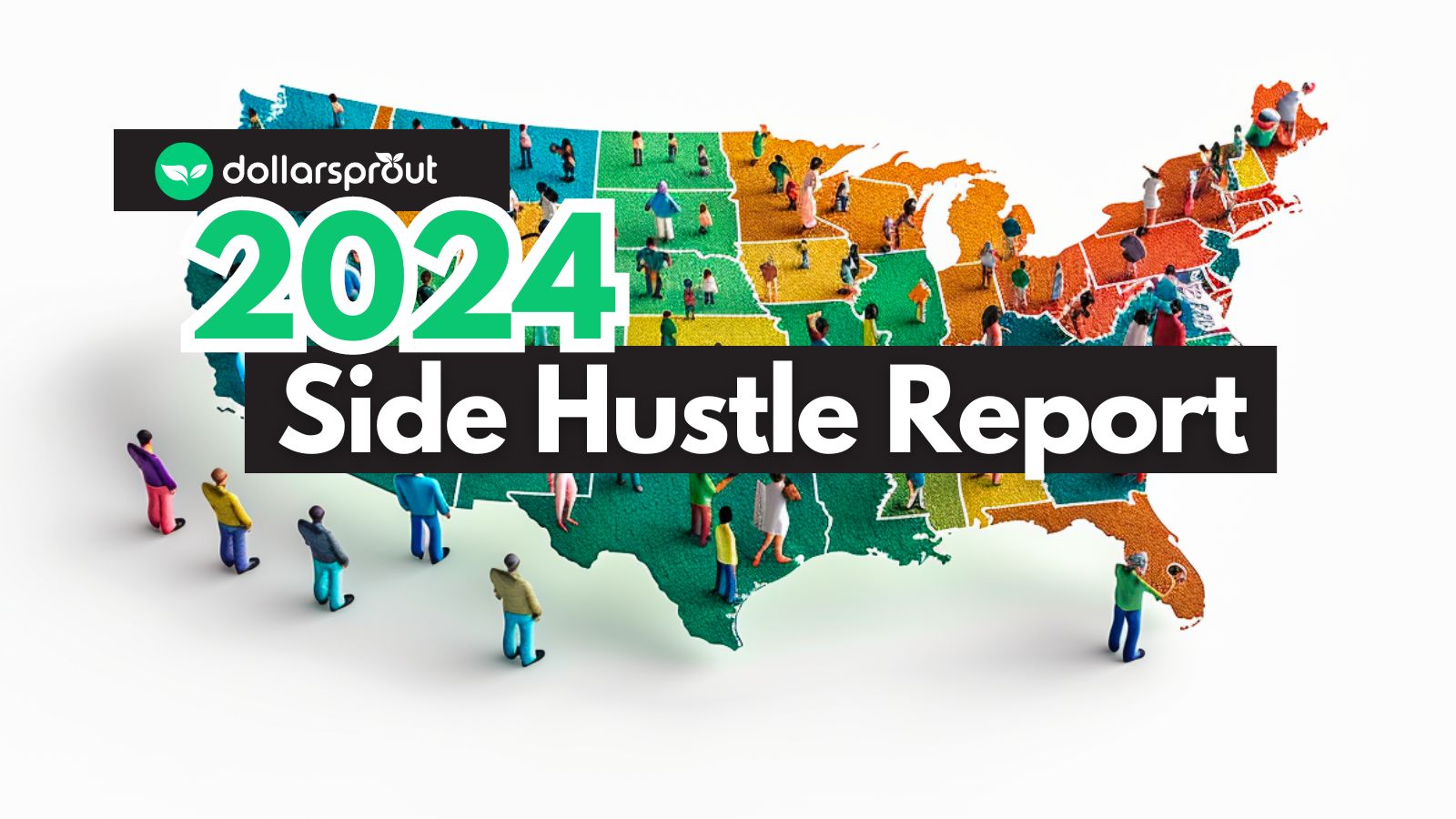
In a world where inflation is here to stay, the allure of side hustles seems to be at an all time high.
With insights from individuals across the United States, our latest study peels back the curtain on the inner workings of the side hustle economy.
It reveals not just the economic motivations driving people towards these additional income streams, but also the personal aspirations and challenges they encounter along the way.
From the time committed each week to the variety of side gigs pursued, and the tangible impact on participants’ wallets, the 2024 Side Hustle Report by DollarSprout offers a comprehensive look into the hustle culture that’s reshaping the American dream. (See Methodology)
Overview of the top side hustle statistics in 2024
Rising living costs, inflation, and economic uncertainty have prompted individuals to seek additional income streams at an astonishing rate.
- 69.6% of Americans now report having a side hustle.
- 115.9 million Americans 16 and older report having a side hustle.
- 68% of side hustlers earn less than $500 per month.
- 12% report earning $1,000 or more per month.
- 72.4% of men and 66.8% of women report pursuing a side gig.
- Millennials make up 55.4% of all side hustlers; Baby Boomers 18.40%.
- Black or African Americans are more likely to side hustle (15.2% participate vs. 13.6% of U.S. population).
- Hispanic Americans are significantly less likely to side hustle (3.2% participate vs. 19.1% of U.S. population).
- Reselling or flipping items (39.40%) and online freelance work (29.80%) were the most side hustles, outside of market research (paid surveys).
- 77.2% of side hustlers are somewhat or highly dependent on earned income.
Survey data
Americans from all walks of life were asked 11 questions about their participation in the side hustle work. Here’s what their responses revealed.
How much are side hustlers earning?
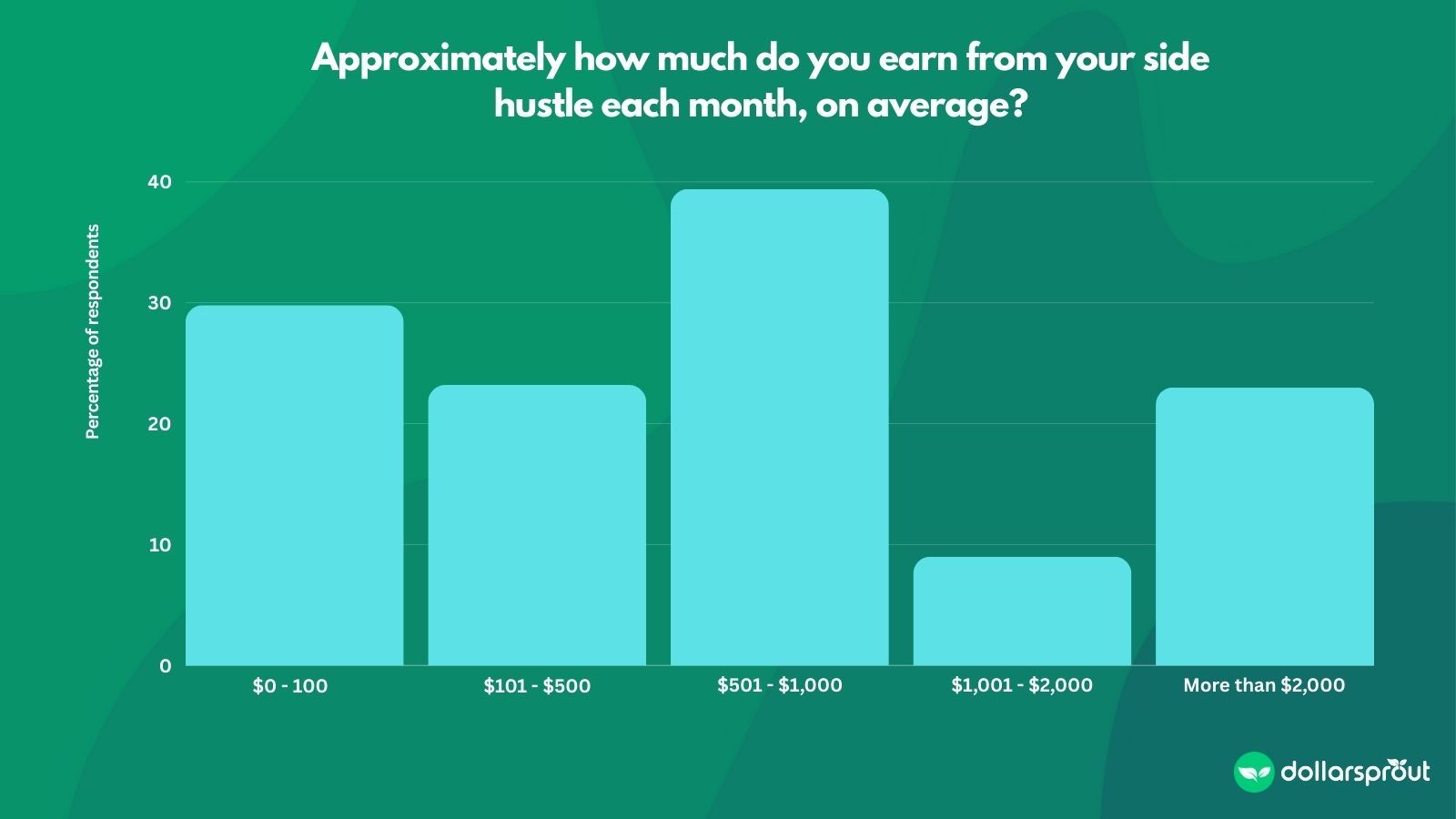
Monthly earnings can vary widely but are generally correlated with how many hours each week someone is putting in.
- $0 – $100: 32%
- $101 – $500: 36%
- $501 – $1,000: 20%
- $1,001 – $2,000: 8%
- More than $2,000: 4%
18% of side hustlers are spending more than 15 hours per week on their side hustle(s).
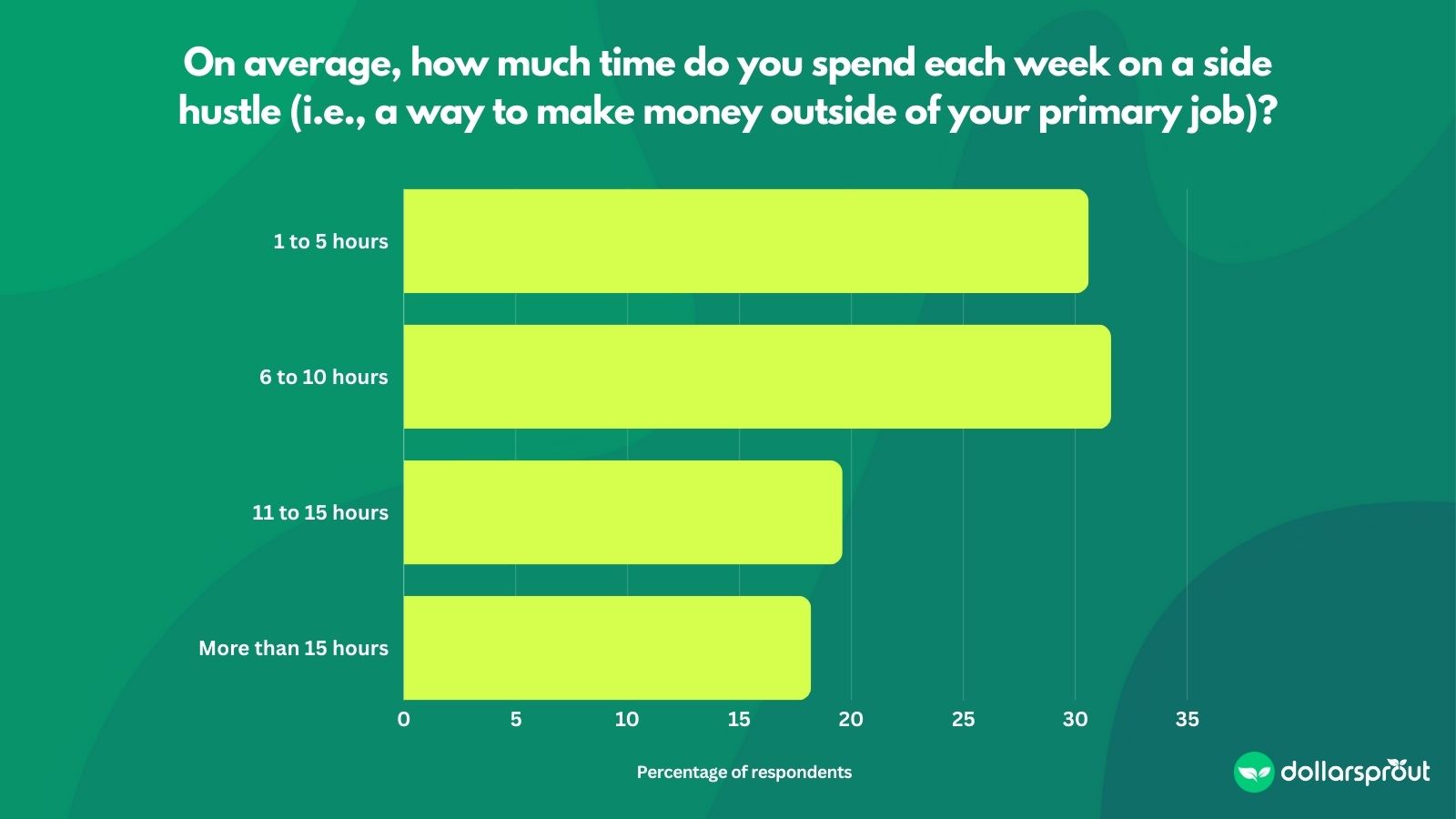
More than 1 in 4 side hustlers depend on that income for everyday expenses
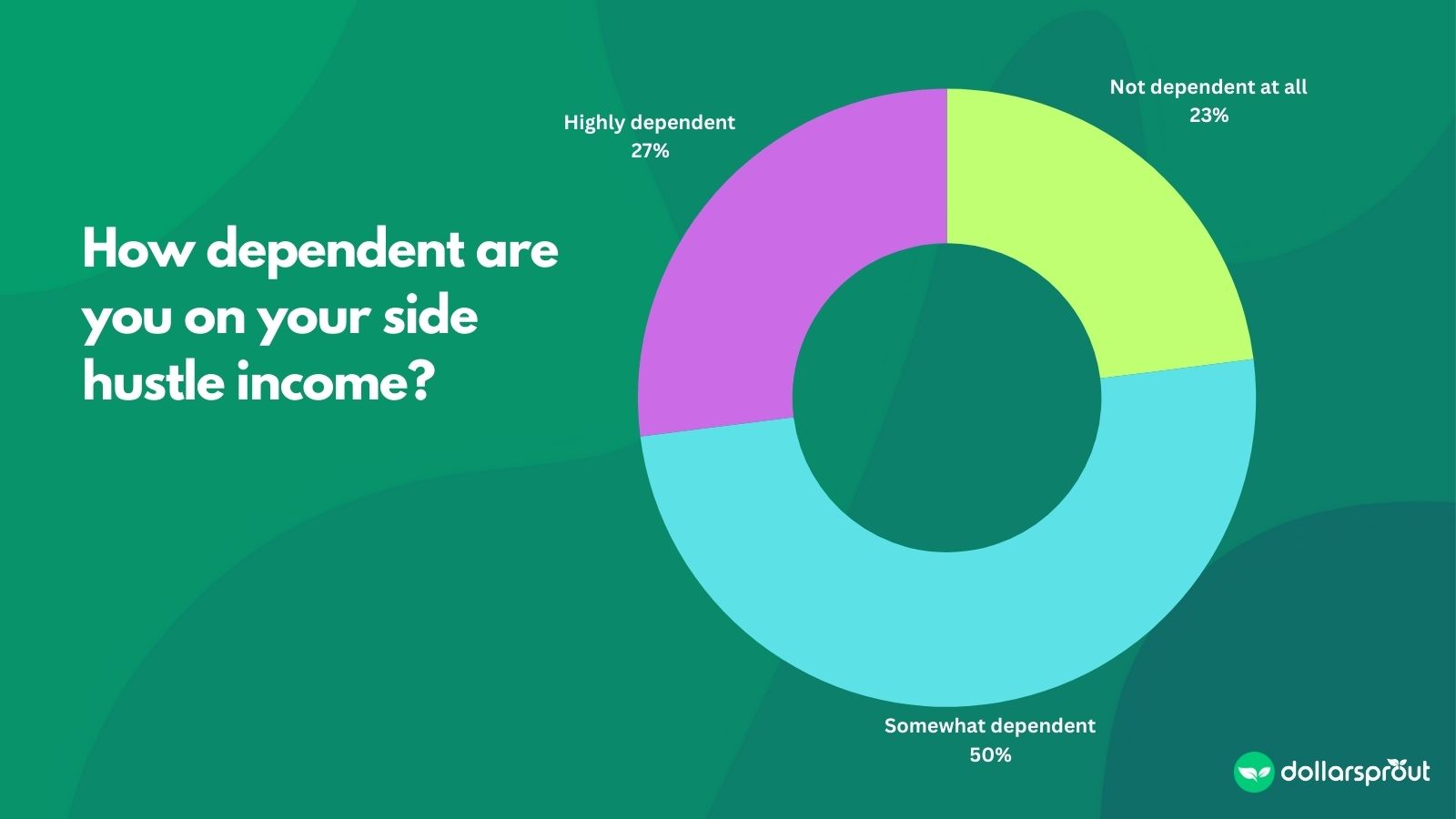
27% of side hustlers are “highly dependent” on the extra income, while 23% are “not dependent at all”.
Money is still the motivating factor for most side hustlers

“Earning extra income” remains the primary motivation for 80% of side hustlers. “Passion and personal interest” were the primary motivation for only 8% of side hustlers.
The impact of AI on side hustlers
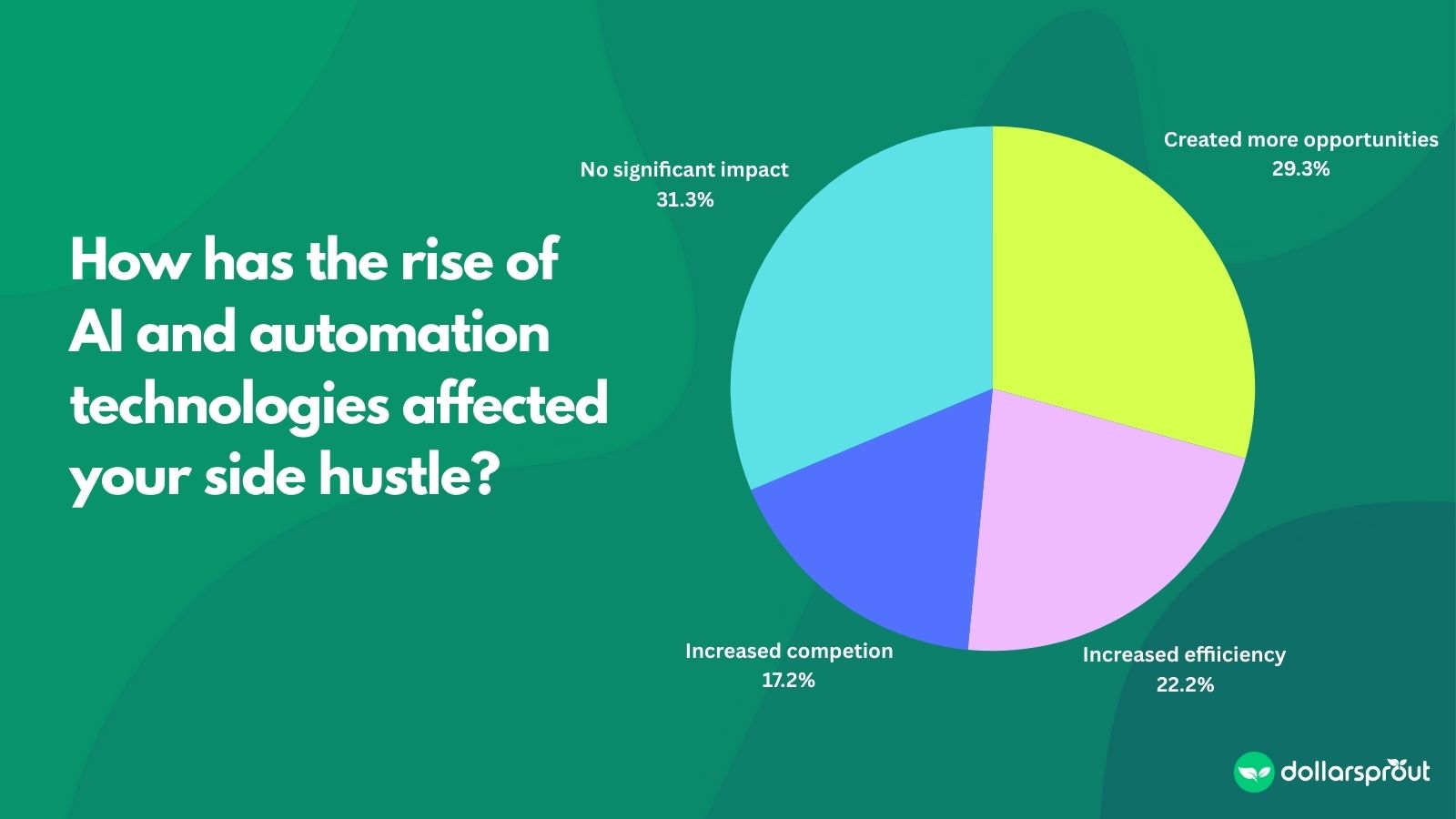
AI tools like ChatGPT have been taking the world by storm over the past year, and side hustlers have definitely started to take notice. Here’s what they had to say about the rise of AI and automation tools:
- 40% say that AI has created more opportunity
- 30% reported increased efficiency
- 24% say it has made their side hustle more competitive
- 42% report that the impact of AI has not yet been significant
How has inflation affected side hustlers?
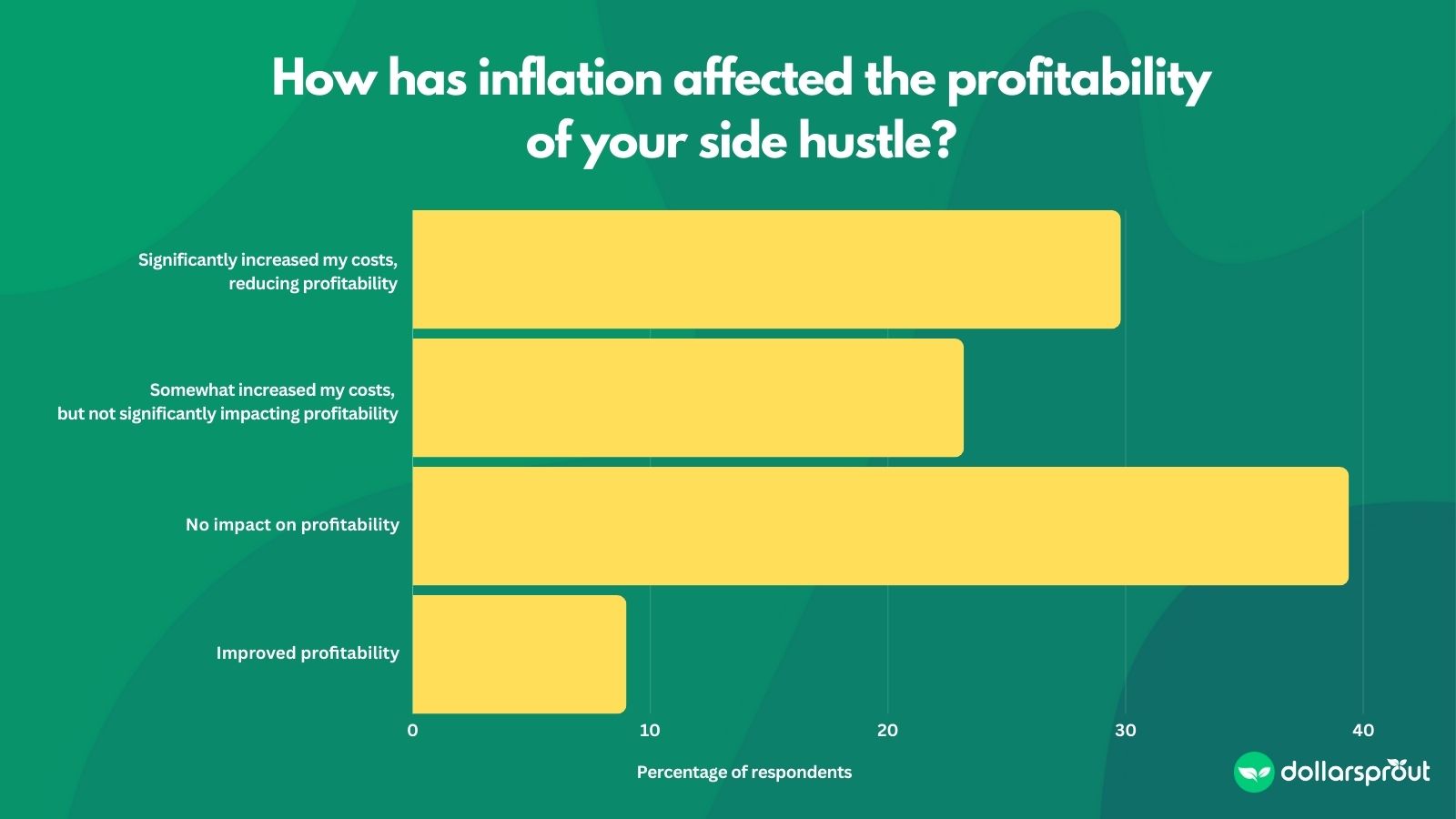
It should come as no surprise that gig workers are also feeling the pinch from inflation. However, there is also a small portion of workers (8%) that say inflation has actually improved profitability for their side hustle.
- 26% of side hustlers report significantly increased costs and reduced profitability
- 30% report somewhat increased costs
- 36% claim that inflation has had no impact on their side hustle yet
- 8% say inflation has improved profitability for them
On the impact of proposed gig work regulations:
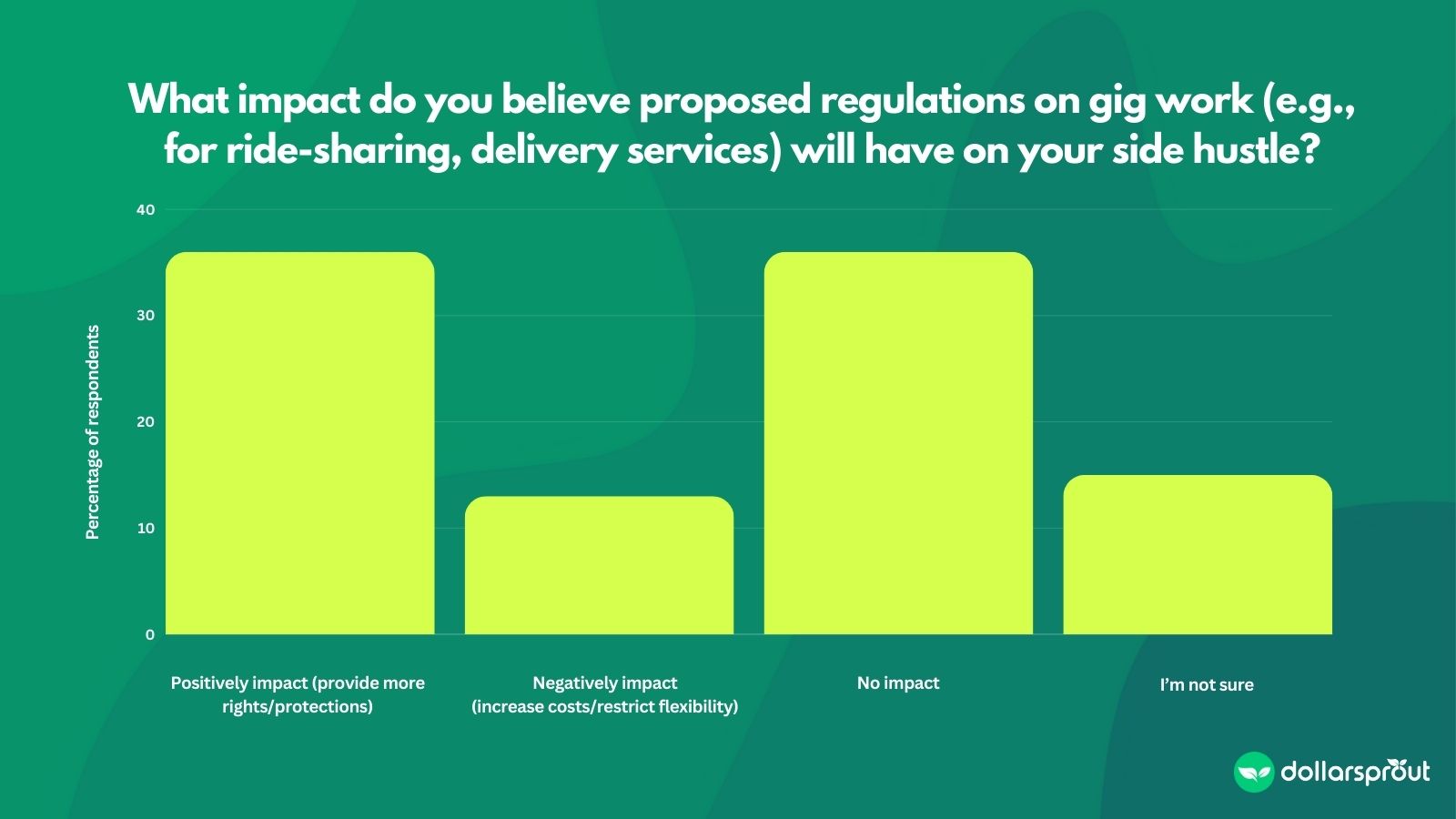
The survey’s findings on proposed regulations for gig work, such as for ride-sharing and delivery services, reveal a wide range of opinions. A notable 39% of respondents believe these regulations will positively impact their side hustles by providing more rights and protections. However, 12% anticipate a negative effect, fearing increased costs and reduced flexibility. The remainder either see no impact or are unsure, reflecting the uncertainty in how regulatory changes could shape the gig economy’s future.
- 39% anticipate a positive impact
- 12% expect a negative impact
- 34% say there will be no impact
- 15% of respondents are unsure
How has the trend of remote work impacted side hustling?

A significant portion of those surveyed (43%) found that the shift towards remote work not only opened up more hours in the day for their side hustles but also enhanced their ability to juggle multiple income streams more effectively. This suggests a positive correlation between the flexibility afforded by remote work and the growth of side hustle activities.
On the other hand, a smaller group (7%) discovered that the benefits and freedoms of remote work diminished their need or desire to pursue additional work.
Outside of surveys, online freelance work and selling goods online are the most popular side hustles
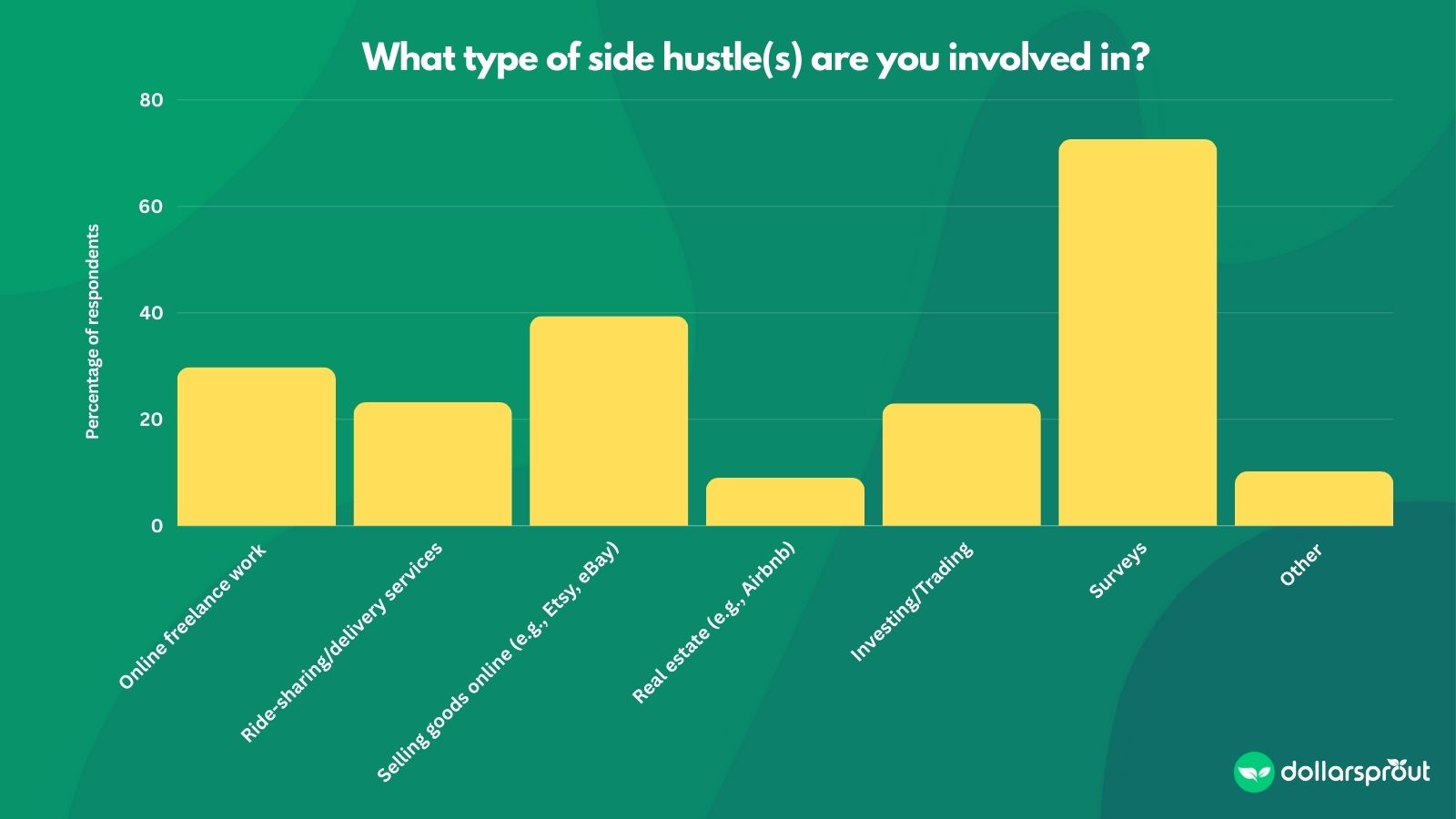
It’s important to note that these results are somewhat skewed since this question was asked in a survey.
Online freelance work and selling goods online have emerged as the most popular side hustles among Americans. This trend clearly shows a growing preference for digital platforms that offer flexible earning opportunities outside of traditional employment.
- Online freelance work (e.g., writing, graphic design): 29.80%
- Ride-sharing/delivery services: 23.20%
- Selling goods online (e.g., Etsy, eBay): 39.40%
- Real estate (e.g., Airbnb): 9.00%
- Investing/Trading: 23.20%
- Surveys: 72.6%
- Other: 10.20%
Note: Respondents were allowed to pick more than one selection in the above question.
Side hustles and the post-pandemic economic recovery
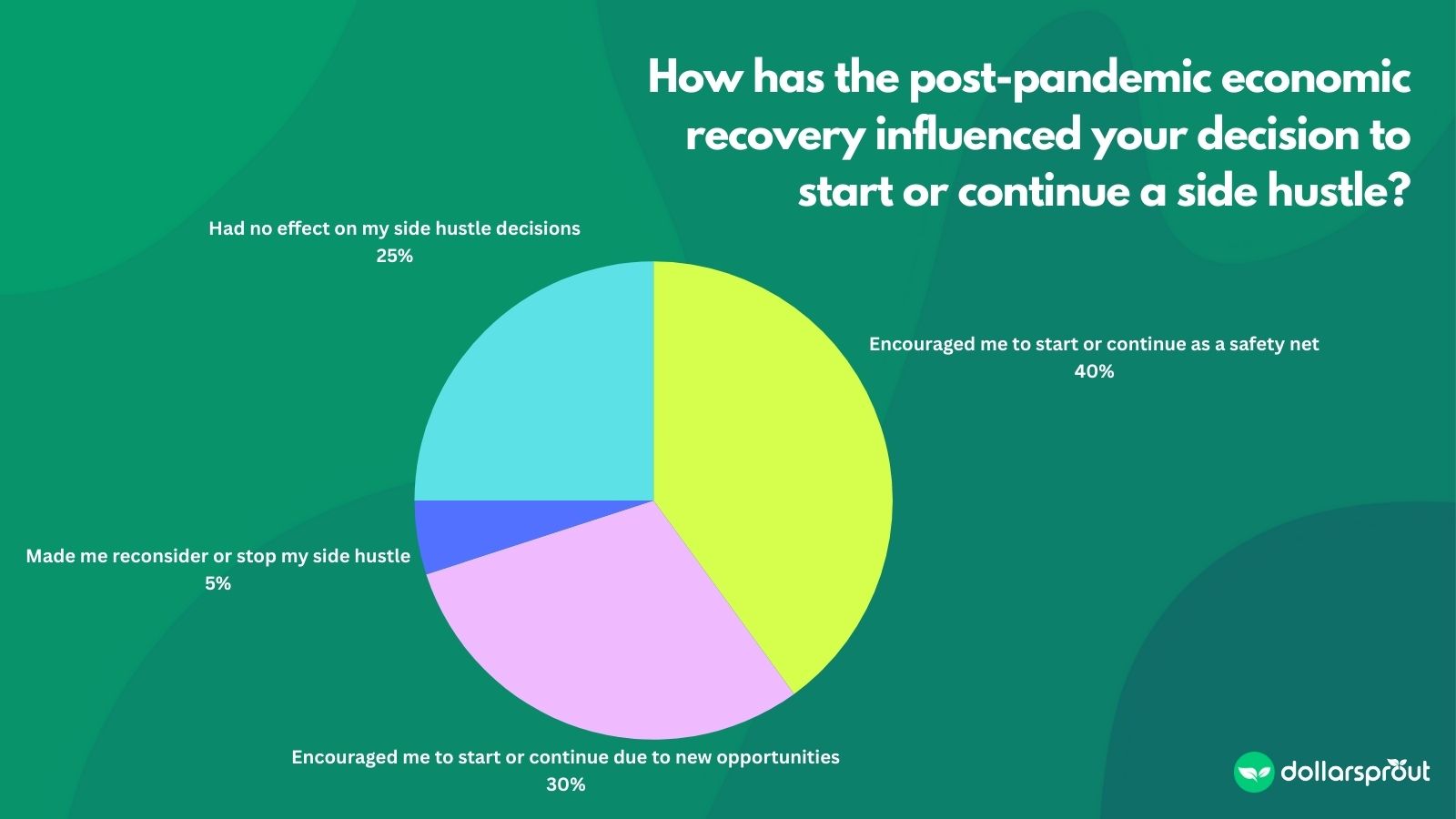
In the context of the post-pandemic economic recovery, our survey found some illuminating statistics: 40% of respondents were encouraged to start or continue their side hustle as a financial safety net, while 31.4% saw it as an opportunity to capitalize on new possibilities emerging from the recovery phase. This indicates a significant portion of the workforce turning to side hustles not only to navigate the uncertainties left in the wake of the pandemic but also to take advantage of the evolving economic landscape. Moreover, a smaller segment, 5.2%, reconsidered or stopped their side hustle activities, possibly reflecting adjustments to new job opportunities or shifts in personal priorities as the economy began to rebound.
An optimistic (or depressing) look into the future, depending on how you look at it
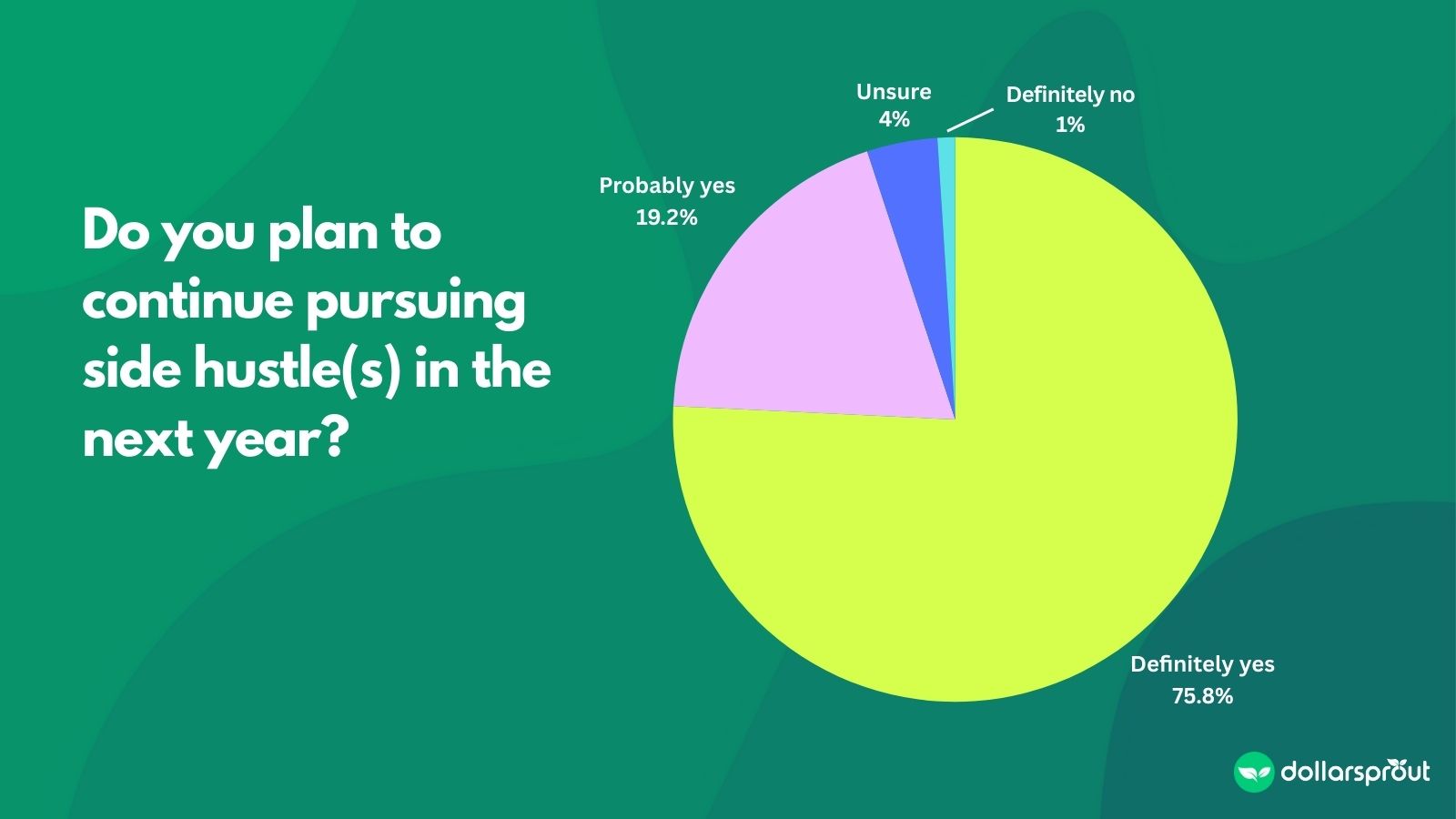
This enthusiasm points to the dual nature of side hustles: they’re not just a way to earn extra money, but also an avenue for pursuing personal passions and interests. However, this growing trend also prompts a deeper examination of our work lives. On the positive side, it showcases a proactive approach toward financial resilience and personal growth. On the flip side, it raises important questions about the sufficiency of primary jobs in fulfilling both our financial needs and career aspirations.
Are we living to work, or working to live?
More background on side hustles
A side hustle is a job or project you take on in addition to your main job, usually to earn extra money. It’s like having a second job but with more flexibility to choose what you do and when you work. People pursue side hustles for various reasons, including to follow a passion, develop new skills, or simply boost their income. Here are a few examples of popular side hustles:
- Online freelance work, such as writing, graphic design, or programming, where you take on projects as they come.
- Ride-sharing or delivery services, where you use your own vehicle to transport people or deliver food and goods.
- Selling goods online through platforms like Etsy or eBay, turning a hobby or crafting skill into a profit.
- Tutoring or teaching online courses in subjects you’re knowledgeable about, from academic topics to personal hobbies.
These are just a handful of the countless side hustle opportunities out there, offering both the chance to earn extra money and the flexibility to fit around your main job or personal commitments.
According to our polling, over 70% of Americans have pursued a side hustle in some capacity — even if only for a few extra dollars each month.
3 smart uses for your side hustle income
If you’re fortunate enough to be sitting on some side hustle cash and wondering the best way to use it, here’s a little guidance to kickstart your decision-making:
Boost Your Emergency Fund: Everyone should have a safety net of three to six months’ worth of living expenses tucked away.
Consider stashing your side hustle earnings in a high-yield savings account. Not only is your money accessible, but it’ll also grow faster than it would in a standard account.
Slash Your Debt: Imagine the relief of being debt-free sooner. You could start small with the debt snowball method or go big by attacking high-interest debts first with the debt avalanche method.
Using your side hustle income to pay down debt can make your financial load a lot lighter.
Treat Yourself: All work and no play? Use some of that hard-earned side hustle money for a bit of fun. Whether it’s a weekend getaway or a fancy dinner, rewarding yourself is a healthy reminder that life isn’t all about the grind.
Methodology
Conducted across the United States via Pollfish, the survey collected data from 500 participants who reported having a side hustle (out of a total sample of 718), ensuring a diverse representation of demographics including age, gender, and primary employment status.
- Age distribution: 18 – 24 (5.6%), 25 – 34 (20.0%), 35 – 44 (35.4%), 45 – 54 (20.6%), >54 (18.4%).
- Gender distribution: Female (47.2%), Male (52.8%)
Participants were presented with 11 qualitative and quantitative questions, the responses of which were combined with 22 Pollfish-provided demographic endpoints to compile the aforementioned statistical inferences.







